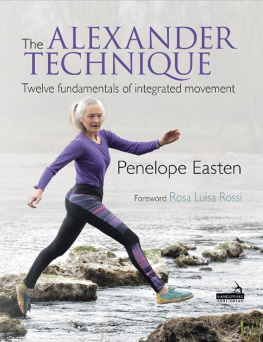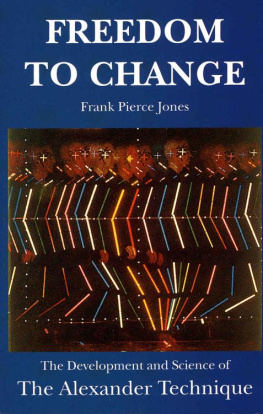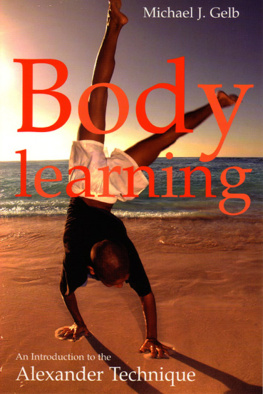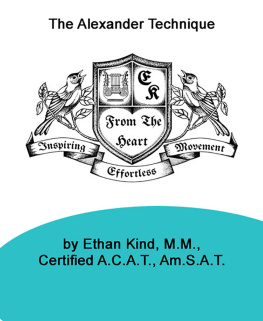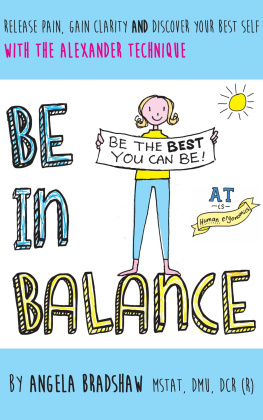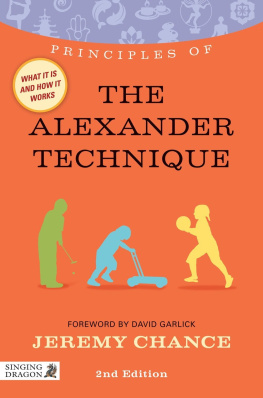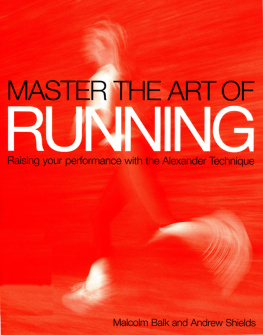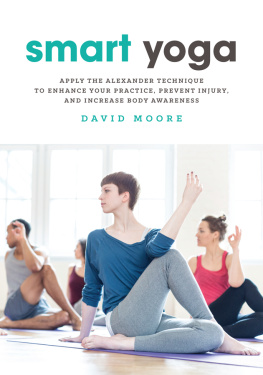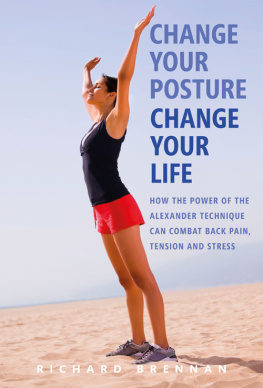
For F. Matthias Alexander,
on whose work our work is founded.
We would like to thank the teachers who trained us in the Alexander Technique: Alma Frank, Lulie West-feldt, and F. Matthias Alexander for Judith Leibowitz; Pamela Anderson, Pearl Ausubel, Deborah Caplan, Ronald Dennis, Lorna Faraldi, Barbara Kent, Judith Leibowitz, Glynn MacDonald, Ann Mathews, Troup Mathews, and Sarnell Ogus for Bill Connington. These teachers aided us on our journeys of exploration into the Alexander Technique and into ourselves. We also extend our thanks to those who read our book in manuscript form and/or offered advice: Dr. John Austin, Pearl Ausubel, Joanne Howell, Amy Kitahata-Sporn, Cynthia Knapp, Cynthia Reynolds, Stacy Title, and David R. Zyla. We appreciate the time our students and colleagues gave in being interviewed for the case studies.
Margaret Wimberger was our first editor and saw our project grow from an idea into a manuscript, providing kind words and support along the way. Susan Randol, our second editor, saw the manuscript through to book form. Susan was an inspiring guide who helped us bring about a tremendous improvement in the book with her focused, constructively critical eye. We thank both of these capable women for their help. We thank Lorraine Williams for her patience and her expert illustrations, and our agent Athos Demetriou who showed great interest in our project and provided invaluable insight and advice.
Our special thanks to Jane Kosminsky for reading the manuscript and for the incredibly generous long-term loan of a macintosh computer.
This book is an introduction to the mind/body method known as the Alexander Technique. Its aim is to help educate the reader as to the design of the human body and the means by which change of habit and attitude may allow the body to work with greater efficiency and ease. The Alexander Technique should not be attempted without the guidance of a fully certified Alexander teacher. The reader is also encouraged to consult a physician before beginning any new regimen of movement. The authors and publisher expressly disclaim responsibility for any unforeseen circumstances resulting from the use of any information or instruction described in this book.
Contents

Title Page
Dedication
I was first introduced to the Alexander Technique when I was a student of acting in the Drama Division of The Juilliard School. The point I remember most vividly from the array of new ideas that were presented to us by our inspired teacher, Judy Leibowitz, was that our movement and posture were habitual: they were learned intuitively by observation and imitation, and that wasnt necessarily good. In fact, to get optimum utility as well as maximum expressibility from our bodies and voices, we would have to relearn from scratch, or at least rethink, how to move and speak. This prospect seemed daunting but intriguing to me as an aspiring actor. As it turned out, the technique, which seemed at first inexhaustibly mysterious, turned out to be an accessible and most enjoyable discipline to learn and to practice.
The many obvious benefits that the technique afforded us as actors included minimized tension, centeredness, vocal relaxation and responsiveness, mind/body connection, and about an inch and a half of additional height.
In addition, I have found in the ensuing years great benefits in my day-to-day living. By balancing and neutralizing tensions, Ive learned to relieve as well as to avoid the aches and pain caused by the thousands of natural shocks that flesh is heir to.
K EVIN K LINE
A secretary with an aching back, a mother with a stiff neck, a dentist with a stoop, a musician with pain in his shoulders, a lawyer feeling fatigued, an actor with vocal difficulties, an athlete with tennis elbow what do they all have in common? They all suffer from excess tension and stress.
The Alexander Technique offers relief for these problems (in some cases eliminating them altogether) by getting to the root of the problem: misuse of the body. These and many other uncomfortable and painful conditions often result from poor posture and movement, which puts a great deal of strain on the body. The Alexander Technique is a subtle method for changing habits and attitudes, which releases the body and mind, enhances body awareness and functioning, and gives the body new freedom, coordination, and energy.
Here are some of the conditions that can result from poor posture and movement which can be alleviated by using the Alexander Technique:
backache
neck and shoulder stiffness and pain
bursitis
whiplash
tennis elbow
arthritis
disc trouble
breathing disorders
stress-related disorders
muscular tics and cramps
swayback
sciatica
pinched nerves
round shoulders
anxiety and tension
Many people believe that standing up straight is enough to improve poor body use. Unfortunately it isnt. In general, good posture is defined as a static position, but unless good posture can be maintained in movement it is transitory and valueless. Proper posture conjures up visions of men in military uniform, finishing school students walking while balancing a book on their heads, or a Vogue model walking down a runway. Stand up straight! Shoulders back! Chest up! Suck in your gut! Tuck your pelvis under! are instructions you may have heard in gym classes, dance classes, or from your mother. If you try to follow this advice you may look a little straighter, but are you comfortable and can you moveor even breathe? You may be able to maintain this rigid position briefly, but chances are you will soon fall back into your old pattern of movement, or your movement will be tense and stiff.
When people decide to change something about themselves, they usually consider only the part that they want to improve. For instance, if a man wants to correct his round shoulders, he may exert muscle tension to pull his shoulders back. But inevitably the effort becomes a strain, and after a few minutes his introduction shoulders will round forward again. He may decide to do exercises to change the position of his shoulders, but if he exercises relying on his inefficient movement habits, the exercises often wont change his condition.
The body functions with maximum efficiency when all its parts are in dynamic balance with one another. When excess tension is released, it is as if a heavy weight is lifted off the body; there is often a sense of relief and of wonder at how much easier movement can be. This letting go of excess tension helps the body release to its full height without straining, thus taking weight off of the joints so that they can move more freely. The Alexander Technique helps you achieve this freedom, not through programmed exercises, but through a mind/body awareness of how you are functioning in daily life.
The method is not just for people who are suffering from pain or stress; it can help anyone who is interested in learning how to move more freely and easily, look and feel better through improved posture and movement, feel more energized, and explore the connection between body and mind.

The Alexander Technique was developed in the last decades of the nineteenth century in Australia by a young Shakespearean actor named F. Matthias Alexander. He suffered from chronic hoarseness when performing, and sometimes lost his voice completely. When neither medical treatment nor vocal study gave him more than temporary relief, Alexander decided to try to solve the problem himself. After many months of painstaking self-observation in a three-way mirror, he saw that the hoarseness was a result of vocal misuse but that this vocal misuse was not an isolated phenomenon. It was only one aspect of an overall pattern of poor functioning in his entire body. He could clearly see his body misuse in the mirror, but he could not feel it. Alexander discovered that every time he opened his mouth to speak he gasped for air, pressed his head down onto the back of his neck, and compressed his spine, which produced tensions throughout his body. His hoarseness was a result of this excessive tension. He had the same habits for everyday speech that he had for performing, but the habits were more pronounced with the added tension of projecting his voice.
Next page

